Xiaomi, well-known as a giant in the smartphone market, has decided to compete for the attention of high-end tech enthusiasts by presenting a MiniLED backlit television. The S MiniLED 2025 model looks truly impressive on paper. An enormous number of dimming zones provides excellent contrast, and the brightness, reaching impressive levels, can impress both in high-quality HDR materials and in older SDR. The television performs exceptionally well where motion smoothness is key. The high refresh rate panel and low input lag make it a good choice not only for sports fans but also for gamers. Support for features like ALLM and GameBar further enhances the gaming experience. Google TV on this television works as it should – quickly, smoothly, without unnecessary stutters, which we couldn't say about the model A Pro 2025. Additionally, with such an extensive app library, it will satisfy even the most demanding user. However, not everything looks so good in practice. Despite solid hardware specifications, the television has its quirks. The biggest issue is the algorithms managing the dimming zones, which can be quite irritating when watching movies in the evening. The performance of individual zones is overly noticeable in dynamic scenes, which can effectively distract our attention from the image. Problems also arise in more demanding HDR scenes despite the truly impressive brightness. Small bright elements often lose brightness, which spoils the effect that high-quality imagery should provide. The system is also not without its shortcomings – features that enhance images in lower-quality materials work unevenly, and some options in Google TV are poorly translated or even untranslated. Xiaomi S MiniLED 2025 has enormous potential, but in its current form, it seems underutilised. It is clear that Xiaomi wanted to do something really good, but a few significant shortcomings lead to a mixed final outcome. A device with high aspirations that needs better software to truly shine. It is an ideal television for brighter rooms, where high screen brightness plays a key role, and issues with local dimming become less noticeable. It will also perform excellently as a screen for gamers and for those who value the versatility and functionality of the Google TV system.
- Matching (Score)
- Our verdict
- TV appearance
- Where to buy
- Contrast and black detail
- HDR effect quality
- Factory color reproduction
- Color reproduction after calibration
- Smoothness of tonal transitions
- Image scaling and smoothness of tonal transitions
- Blur and motion smoothness
- Console compatibility and gaming features
- Input lag
- Compatibility with PC
- Viewing angles
- TV efficiency during daytime
- Details about the matrix
- TV features
- Apps
- Playing files from USB
- Sound
Xiaomi S Mini 2025 vs XIAOMI A PRO 2026
Direct compare

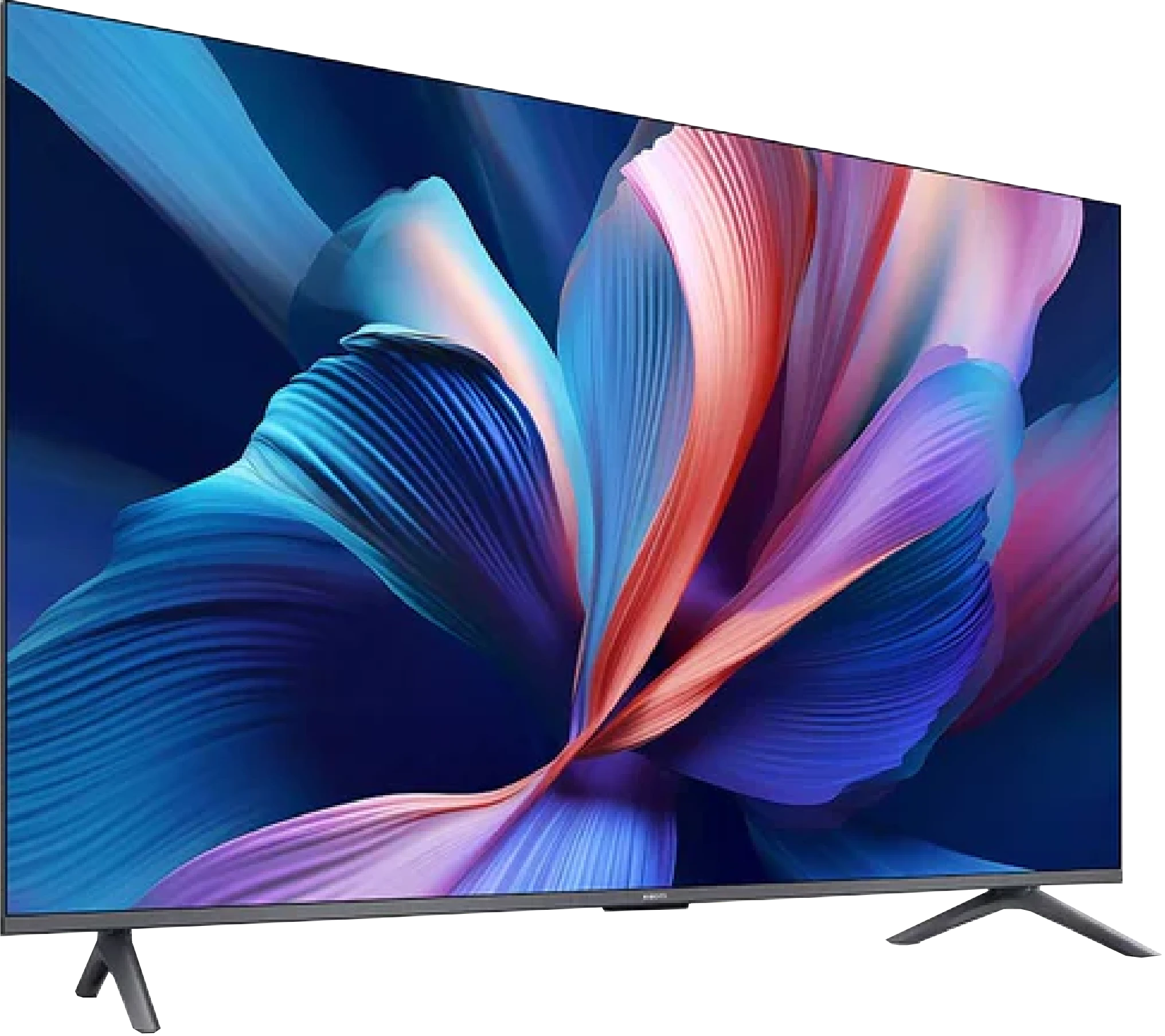
Panel type: LCD VA
Resolution: 3840x2160
System: Google TV
Model year: 2024
Complete the survey to find out the result

Panel type: LCD VA
Resolution: 3840x2160
System: Google TV
Model year: 2025
Complete the survey to find out the result

Overall rating
7.1
5.6
Movies and series in UHD quality
6.4
6.0
Classic TV, YouTube
6.6
5.7
Sports broadcasts (TV and apps)
6.5
4.7
Gaming on console
8.4
6.2
TV as a computer monitor
8.2
2.0
Watching in bright light
7.3
4.9
Utility functions
4.7
6.1
Apps
9.6
9.6
Sound quality
6.8
5.0
Complete the survey to find out what fits your preferences
Advantages
VA panel with MiniLED backlighting – decent contrast and deep blacks
High brightness (841 cd/m²) – excellent visibility even in bright rooms
Support for multiple HDR formats: Dolby Vision, HDR10+
High refresh rate: 240Hz, 144Hz, and 120Hz
Low input lag – perfect for gaming
Google TV system – versatile and extensive with broad access to apps
The remote does not require aiming at the screen
Pleasant sound with a light bass
Support for audio formats: Dolby Atmos and DTS:X
VA panel with good native contrast and decent blacks
Supports Game Boost mode at 120 Hz in 1080p and 1440p
Low input lag in 120 Hz mode
Google TV – vast selection of apps and services
Wide colour gamut coverage (around 94% DCI-P3)
Good colours after calibration in SDR mode
Supports popular audio formats (Dolby Atmos, DTS:X)
Large, easy-to-read remote with numeric keypad – convenient for seniors
Disadvantages
Errors in the TV menu translation
Issues with aggressive dimming algorithms – noticeable in dynamic scenes
Image scaling and tonal transition enhancement functions are unstable
Low brightness
Lack of real support for HDR10+ and other more advanced HDR formats (e.g., Dolby Vision)
Significant limitations when working with PC – no chroma 4:4:4, heavy dithering, poor font readability
Poor viewing angles (typical for VA)
Clunky build, legs mounted in plastic with screws
Weird system issues – stuttering, errors with Miracast and sound switching
Upscaling and digital image processing is virtually non-existent
Very weak sound, practically no bass (we felt it performed worse than the "2025" model)
Our verdict
Xiaomi A Pro 2026 is a television that, at first glance, doesn’t reveal significant changes compared to its predecessor. Someone might even think it’s just a copy of last year's model with a different sticker. And there’s some truth to that, as the main novelty, or rather the only noticeable difference, is the 120 Hz mode at lower resolutions. It must be said that Xiaomi has done well here; this addition really makes a difference – it’s not a solution for professional gamers, but a nod towards those looking for a smoother image during casual gaming. This is where the A Pro 2026 can stand out – with a simple yet clever idea that sets it apart in the “super budget” segment. Unfortunately, when we start looking at the television more broadly, the enthusiasm quickly wanes. Even though the year has changed on the calendar, most of the issues known from the A Pro 2025 are still with us – the system can still experience strange stutters, and the occasional errors can be quite frustrating. On top of that, there's a lack of any serious digital image processing tools, which worked quite decently last year. As a result, there are many limitations in the design that the competition in a similar price range is already trying to cover up in some way. When it comes to image quality, we won't sugarcoat it either. Brightness at the level of 200–300 nits doesn’t stand a chance against more demanding content. Sure, with simpler streaming content, you can watch something, but with high-budget productions, it’s immediately clear why the television costs what it does. The impression that we are viewing a flat image stripped of details accompanies us pretty much every time. And this brings us to the crux of the matter. The Xiaomi A Pro 2026 is a television for those who really don’t demand much. As a daily screen for series, news, or YouTube, it performs decently, especially thanks to its operating system, which is GoogleTV. Also, if someone is looking for budget equipment and would additionally like a taste of smoother gameplay in games thanks to the 120 Hz mode, they might even be satisfied. However, anyone expecting at least average image quality, a stable system, and proper functionality will soon notice that there are other budget models on the market that simply perform better.
TV appearance




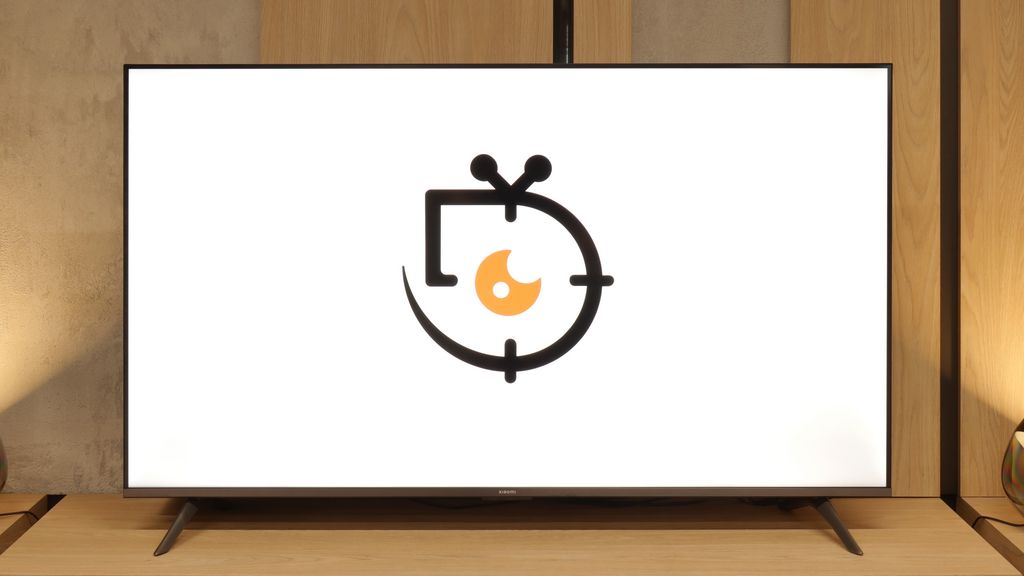
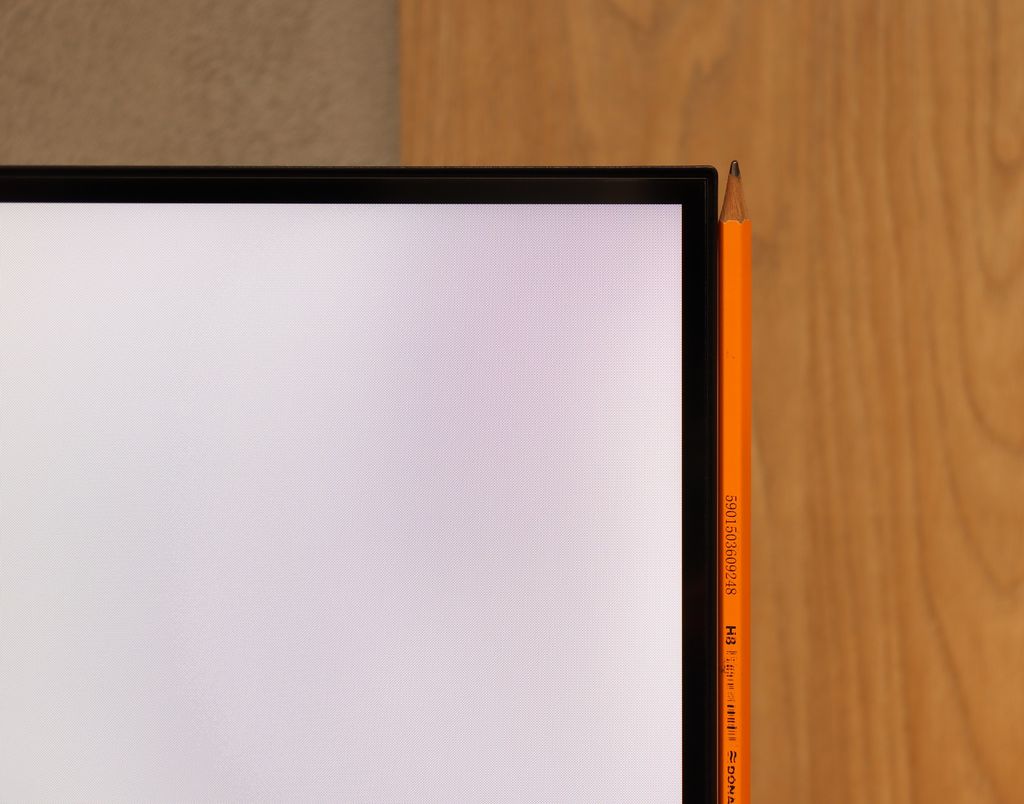
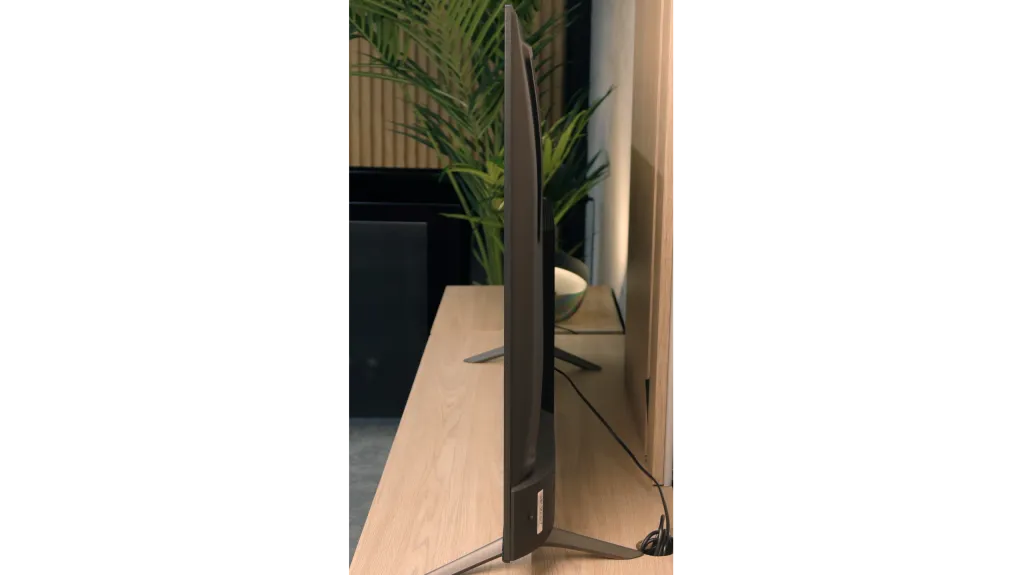
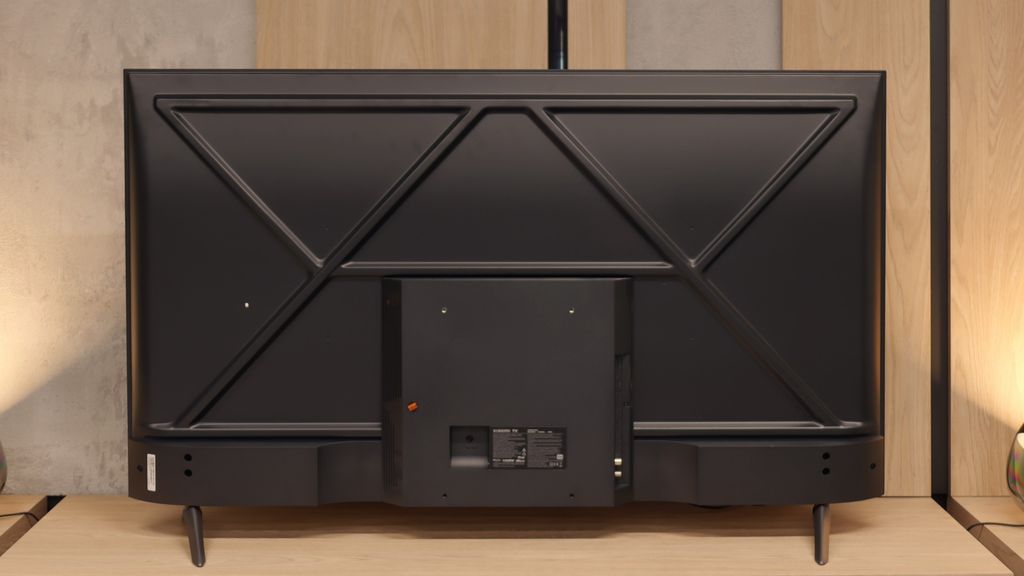
Contrast and black detail
6.8/10
6.1/10
Local dimming function: Yes, number of zones: 308 (22 x 14)
Local dimming function: No
Contrast:

Result
182,000:1

Result
38,050:1

Result
18,300:1

Result
10,150:1

Result
5,450:1

Result
5,000:1

Result
6,550:1

Result
7,300:1

Result
6,600:1

Result
4,900:1
Halo effect and black detail visibility:

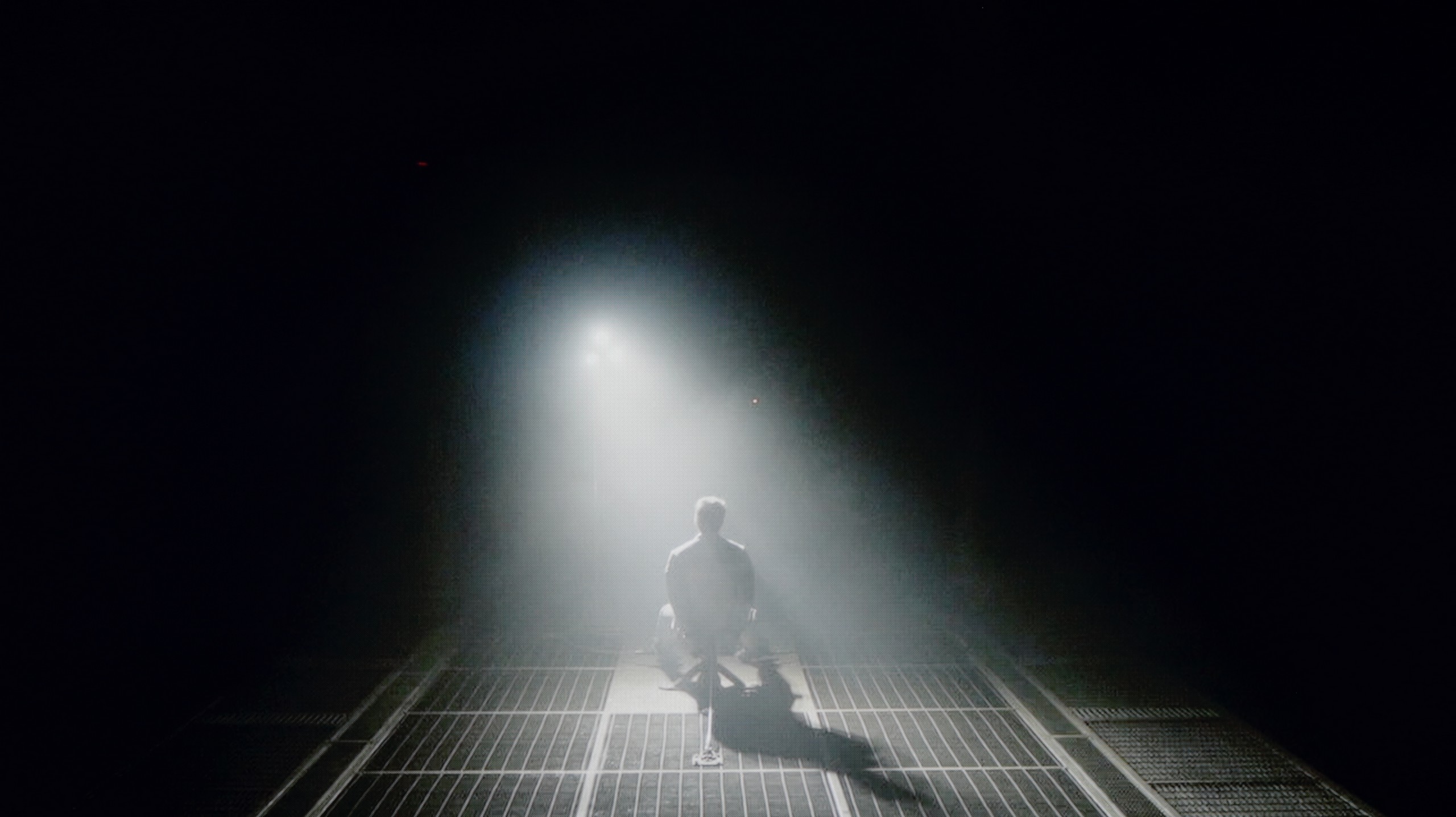
Xiaomi S MiniLED is one of the most affordable televisions with MiniLED technology available on the market. The model we tested, sized at 55 inches, is equipped with as many as 308 local dimming zones, which is impressive for such a price. Additionally, it features a VA panel, which inherently offers significantly better contrast than IPS panels. On static test screens, the television performed excellently, achieving an impressive contrast ratio of 182,000:1 in the film Oblivion. Blacks were deep, and details in both bright and dark areas of the image were clearly separated. However, in more demanding scenes where the image is dynamic, the situation begins to complicate.
Where lies the problem? The main cause is the local dimming algorithms. Although on static images, their effects are promising, during movie playback – which reflects the television's natural working conditions – they operate too aggressively. In dynamic scenes, like those from the tested film, one can see how the individual dimming zones "work and flicker," which detracts from the viewer's sense of image coherence. This effect is particularly noticeable in motion, when bright objects move against a dark screen. As a result, although Xiaomi S MiniLED offers fantastic contrast on paper, in practice, the effect is less satisfying. The aggressive operation of the algorithms ruins the perception of dynamic scenes, making the television perform average in this category. This is a good example of how MiniLED technology requires not only a good specification but also adequate optimisation.
One of the biggest advantages of even a budget construction like the Xiaomi A Pro 2026 is the VA panel it uses. This is responsible for quite decent contrast, which in our measurements oscillated between 5000:1 and 7000:1. On the screen, this translates to a stable image with fairly deep blacks – something that's hard to find in competing models with IPS panels without local dimming. Xiaomi has also added a global dimming function for the entire panel. It sounds good, but… we advise turning it off straight away. Why? Because the screen behaves very strangely in darker scenes – sometimes it dims so much that you can hardly see anything, and other times it brightens so much that the already dark blue-black turns into a bright blue. At those moments, it felt as if the TV was simply damaged. Fortunately, without this function, the contrast looks really solid. It’s definitely not on the level of advanced TVs with local dimming, but in its price range, it will easily satisfy most users – especially if you’re not watching in a completely dark room and have at least some background light that effectively masks the imperfections of the "blue-black".
HDR effect quality
4.8/10
4.1/10
Luminance measurements in HDR:

Result
852 nit

Result
140 nit

Result
385 nit

Result
97 nit

Result
1126 nit

Result
220 nit

Result
248 nit

Result
322 nit

Result
315 nit

Result
326 nit
Scene from the movie “Pan” (about 2800 nits)


Scene from the movie “Billy Lynn” (about 1100 nits)


Static HDR10


Dynamic: Dolby Vision
Dynamic: HDR10+


HDR luminance chart:
XIAOMI A PRO 2026
HDR luminance
Xiaomi S Mini 2025
HDR luminance
Since Xiaomi S MiniLED boasts an impressive 308 zones of dimming, it's time to see how it performs in HDR tests. Starting with luminance, or the ability to display bright scenes, the television achieved nearly 1000 nits of brightness – a result that can be considered outstanding in this class. But do these numbers translate to real-life experiences in film scenes? In the case of less demanding shots, such as those from the film The Meg, the television indeed delivered excellent results, reaching up to 900 nits. Such values are impressive and can truly convey the strength of HDR effects.
Unfortunately, just like with contrast, there were some issues. When smaller, brighter elements appear on the screen – as in challenging scenes from Sicario 2 – the aggressive action of the dimming zones ruins the entire effect. Brightness in these moments drops to just 100 nits. That is definitely too little to convey the full magic of HDR. Instead of a dynamic and detailed image, the viewer gets a muted, almost flat impression, which takes away all the enjoyment of the viewing experience.
In summary, if we're looking for a television with high brightness for watching movies during the day, the Xiaomi S MiniLED will easily fulfill that task. However, its inability to precisely manage the dimming zones makes watching movies in the evening, especially during demanding HDR scenes, potentially more frustrating than satisfying.
If you're counting on the cinematic HDR experience in the new Xiaomi A Pro 2026, it's best to temper your expectations. This TV is simply too dim to fully realise the potential of contemporary films or series designed for the highest quality image. Our measurements showed brightness levels in the range of 200–300 nits, which are values that are more suited to SDR content than to ambitious HDR productions. In practice, this means that while most films look decent, they certainly won't evoke the 'wow' effect that other TVs do. Fortunately, not everything is lost – credit has to be given to the PFS LED filter used here, a solution similar to the quantum dot technology found in QLEDs. Thanks to this, the coverage of the DCI-P3 colour palette reaches about 94%, resulting in vibrant, saturated colours in the vast majority of materials.
Factory color reproduction
3.9/10
3.5/10


Factory Mode
After calibration


Factory Mode
After calibration
Xiaomi, like many manufacturers, offers a wide range of picture modes. On the S MiniLED, we can find both IMAX Enhanced and Filmmaker. Our tests were conducted in Filmmaker mode, which theoretically aims to reference the image, but the reality turned out to be somewhat different.
Let’s start with the SDR material tests. Here the TV had quite a few problems, especially with white balance. The noticeable dominance of red made the image appear too warm, and all colours gained a reddish hue. This was particularly evident in the comparative scene from the film Star Wars. The brightness characteristic (gamma) also left much to be desired – instead of a smooth transition, we had a real "rollercoaster," with visible excessive brightening of the screen.
In 4K materials, the situation looked considerably better. The white balance, though still not perfect, was much more balanced, with a slight dominance of red and blue, but no excessive impact on the overall perception. The EOTF curve (responsible for brightness in HDR) showed some brightening in the brightest parts of the image, which was noticeable in the test scene from the film Pan that we described above. These brightening effects may disturb the precision of the image, but in 4K, the overall effect was far more acceptable than in SDR.
Although Xiaomi S MiniLED can pleasantly surprise in 4K materials, its factory settings in SDR require significant corrections, especially regarding white balance and brightness. It's definitely a TV that would benefit from calibration.
What we saw in Filmmaker mode really surprised us – and unfortunately not in a good way. The mode advertised as the Hollywood standard resembled more of a display in a shop window. The white balance was shifted towards blue, which led to massive colour errors and the effect of blown-out scenes in SDR content. It was a bit better, though far from perfect, in HDR materials. There were also problems there – colour saturation and the entire palette consistently drifted towards cooler tones, resulting in an image that had an artificial, cold tint rather than a cinematic character. In other words: even in Filmmaker mode, which should be the showcase of this television, we got an effect far from expectations.
Color reproduction after calibration
8.4/10
7/10




Xiaomi S MiniLED 2025 is a television that gains a whole new life after calibration. The results are truly impressive and show how much potential this model has.
In SDR mode, the white balance is almost perfectly aligned. The errors are so minimal that in many cases they can be considered negligible. This is confirmed by the Colour Checker palette results, where errors did not exceed 2 ΔE – a truly rare outcome. Gamma also performs very well, although there are slight brightening effects in the darkest elements at the beginning of the graph. However, this is a minor exception that does not significantly affect the viewing experience.
In 4K HDR material, calibration also brought visible improvements, particularly in white balance. The image looks natural and consistent. However, the characteristic of brightness remains an issue. EOTF analysis in film materials shows that the television tends to overly brighten or darken the smallest elements on the screen. This is the effect of limitations in the dimming algorithms that we previously discussed regarding HDR and contrast testing. Unfortunately, this is a technical feature of this model that cannot be completely eliminated.
Despite this minor flaw, calibration has allowed us to extract the maximum capabilities from this television. The image now looks phenomenal, and its quality impresses in every type of material. Xiaomi S MiniLED 2025 demonstrates that with the right settings, it can compete with more expensive models.
Even though Xiaomi isn't a brand associated with top-tier televisions, it's fair to say that even in a budget model like the A Pro 2026, the manufacturer left plenty of calibration settings. After a few adjustments, the SDR picture took on a completely new look. The colours stopped veering into blue tones, the whites gained a sense of naturalness, and most errors dropped to a practically invisible level. As a result, SDR content looked very good, surprisingly so for this price range.
It was a slightly different story with HDR materials. Here, it was immediately noticeable what we had already mentioned – the overexposure of bright scenes and issues with balance control. Calibration helped only partially, as the limitations of the panel itself were at play. However, it must be emphasized that in the case of SDR, the television changed beyond recognition, and definitely for the better.
Smoothness of tonal transitions
8/10
9.3/10












The fluidity of tonal transitions in Xiaomi S MiniLED 2025 looks very good. Even in the theoretically most challenging scene with red water, the television performs excellently – we did not notice any major issues. Minor imperfections occur in scenes like Kingsman or The Martian, where you can see subtle colour blending. Nevertheless, Xiaomi stands out in this category, offering one of the best qualities of tonal transitions in its price range. This is definitely a strong point of this television.
The television really handles colour blending well, and in most scenes it's hard to spot any imperfections. This is best showcased in the brighter parts of films, where tonal transitions look almost perfect, and the image is smooth and natural. Darker scenes are somewhat less impressive, where the characteristic banding can be seen. Fortunately, this isn't a flaw that stands out, and for most viewers, it will remain virtually unnoticeable.
Image scaling and smoothness of tonal transitions
6.7/10
3/10
Smooth transition function


Image without overscan on the SD signal


When it comes to tonal transitions in lower-quality materials, such as YouTube or television, the Xiaomi S MiniLED comes with a feature called “Colour Contour Removal.” In the "low" setting, it works quite well, but its effectiveness can be uneven. Sometimes it appears as if the TV struggles to smooth things out, which creates a bit of dissonance. On the plus side, we didn’t notice any visible side effects, although given the instability of this feature, one might suspect that unexpected issues could arise in certain situations.
Image scaling also comes across as average. There’s slight jaggedness, especially on thin elements like branches, and text can be a bit ragged. It may not be overly bothersome, but a more discerning eye will certainly catch these imperfections. Overall, most users should be satisfied with the scaling and smoothing quality, but the TV may not satisfy those who expect perfection in every frame.
Upscaling and digital image processing in the Xiaomi A Pro 2026 are not among the model's strong points. One might expect that since the television was not designed to achieve record brightness levels, the manufacturer would have opted for a more robust processor and a set of features that would "enhance" lower quality images. Unfortunately – we were also met with significant disappointment here. On the plus side, it has reasonably decent upscaling, which handles HD content and boosts it to 4K in an acceptable manner. However, that is where the list of advantages ends. The television does not offer any features to improve tonal transitions or smooth out digital imperfections, so in most cases, we receive a raw image, exactly as we deliver it from an external source. On a large screen, this lack of support makes lower quality content look simply bland. An additional problem is the phenomenon of overscan. When watching older material, it happens that part of the image is cut off, which only intensifies the impression that Xiaomi has quite a bit of catching up to do in this category.
Blur and motion smoothness
7/10
4.5/10

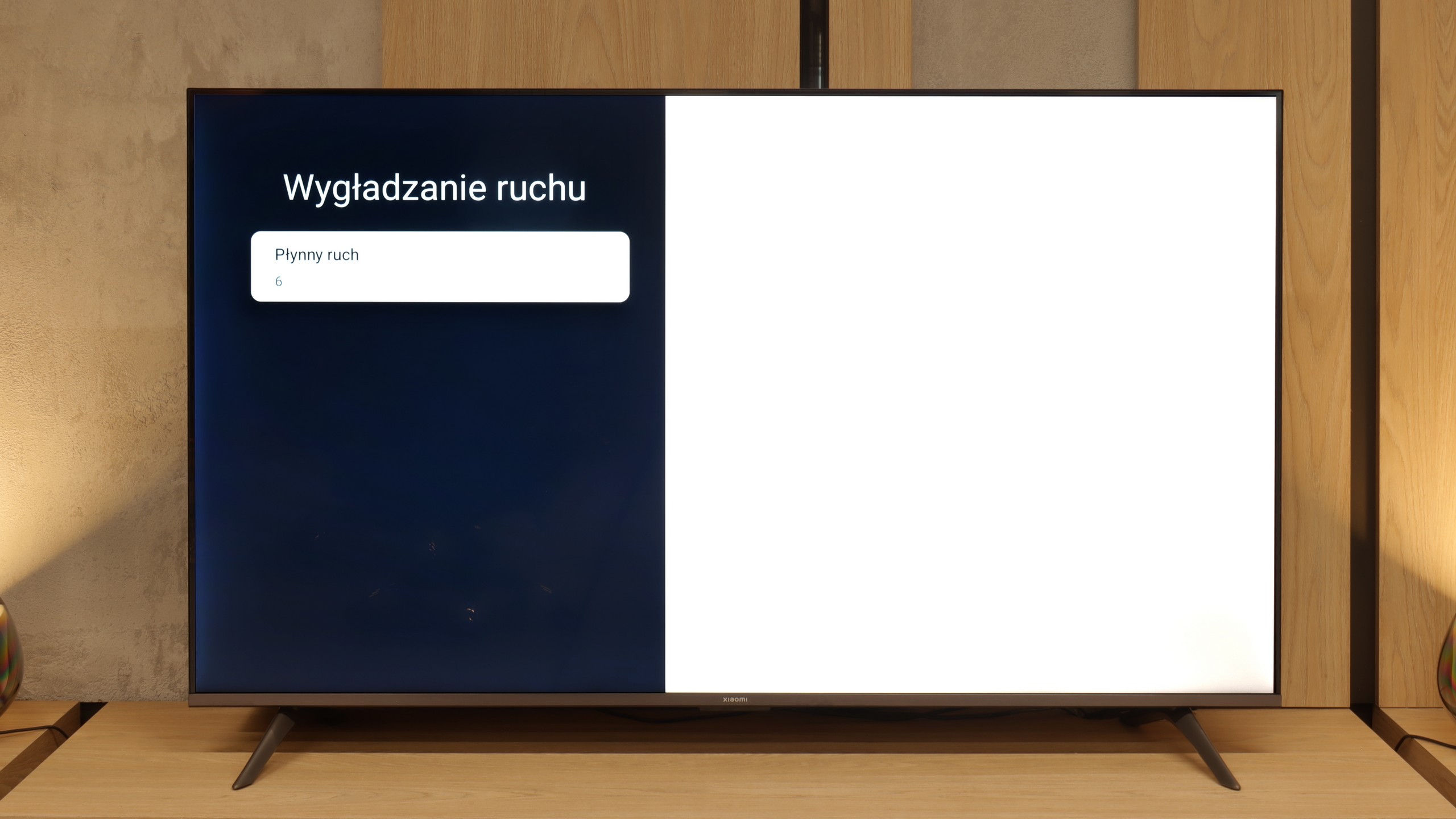
Blur (native resolution, maximum refresh rate):






Smużenie ():
Smużenie (1440p@120Hz):



Xiaomi S MiniLED 2025 is equipped with a 4K@120Hz (1080p@240Hz) refresh rate panel, providing sufficient smoothness for both watching dynamic sports broadcasts and playing the latest games. This level of refresh rate makes the image look fluid, even in the most intense scenes. Additionally, the television offers a "Motion Smoothing" feature that allows users to adjust the way the image is displayed in films. We can choose a more choppy effect, typical for cinematic experiences, or a smoother one, resembling the so-called "theatrical effect". As a result, every user can tailor the settings to their preferences and enjoy smooth images in their favourite content.
The motion fluidity in the Xiaomi A Pro 2026 is an interesting compromise that results from the hybrid matrix used here. At a native resolution of 4K, the maximum refresh rate is 60 Hz – sufficient for those who mainly watch movies and series. It is with them in mind that the manufacturer added a motion smoother, allowing users to adjust the image to their own preferences – one can opt for greater fluidity or leave it with more "cinematic" frames depending on the settings.
Console compatibility and gaming features
9.8/10
3.6/10
- ALLM
- VRR
- VRR range48 - 144Hz
- Dolby Vision Game Mode
- Correct implementation of HGIG
- 1080p@120Hz
- 1440p@120Hz
- 4K@120Hz
- Game bar

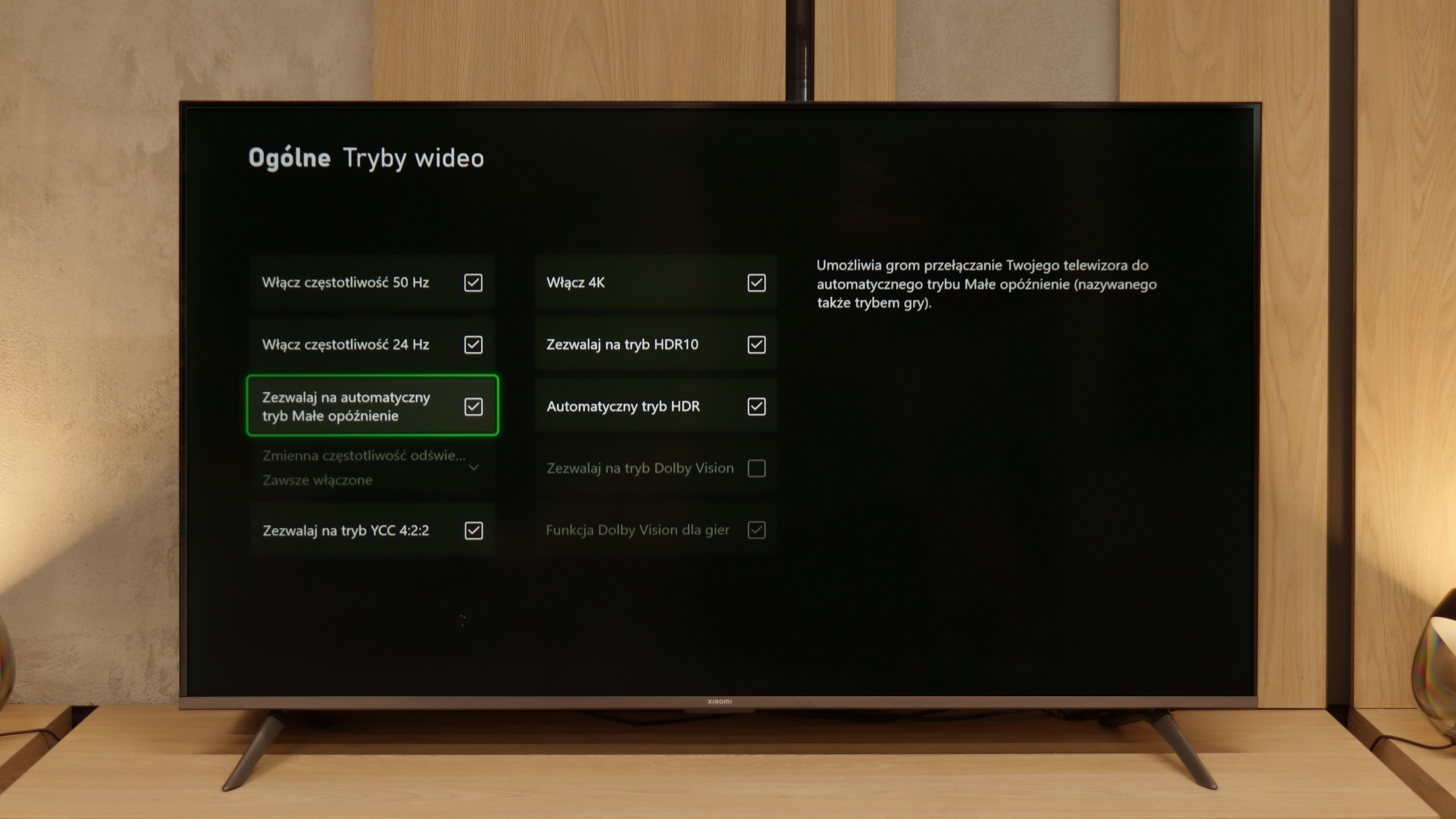

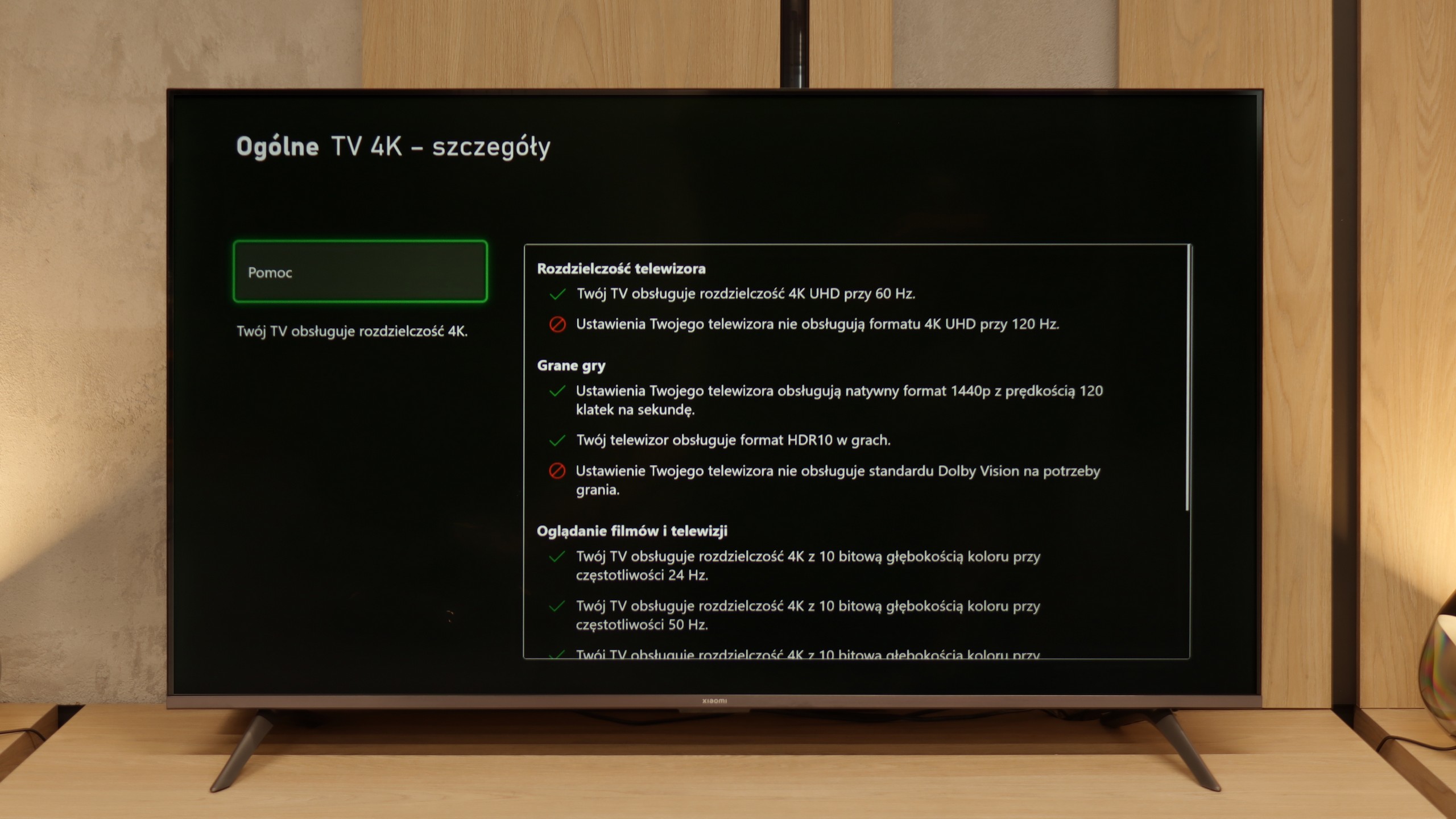

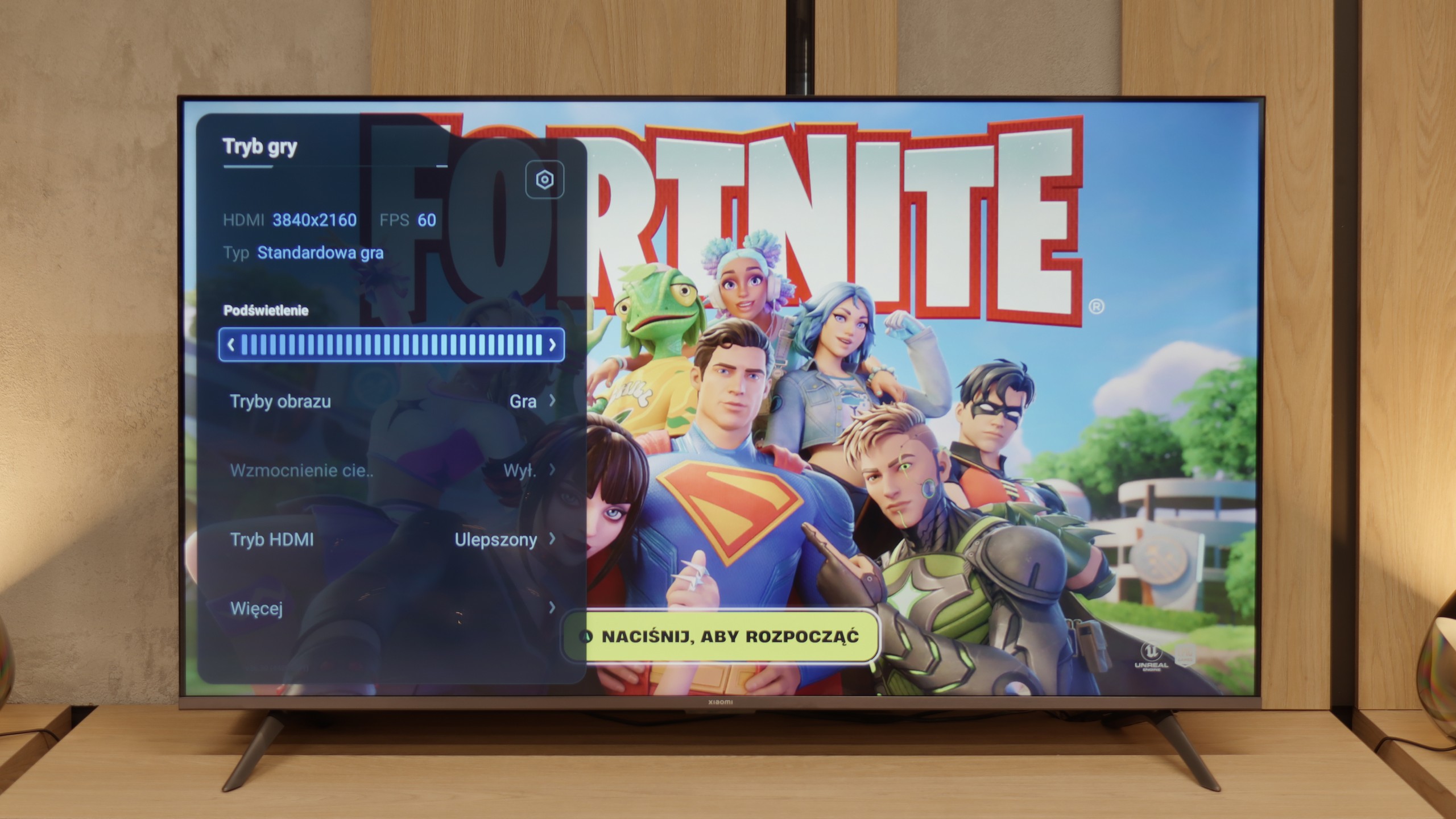

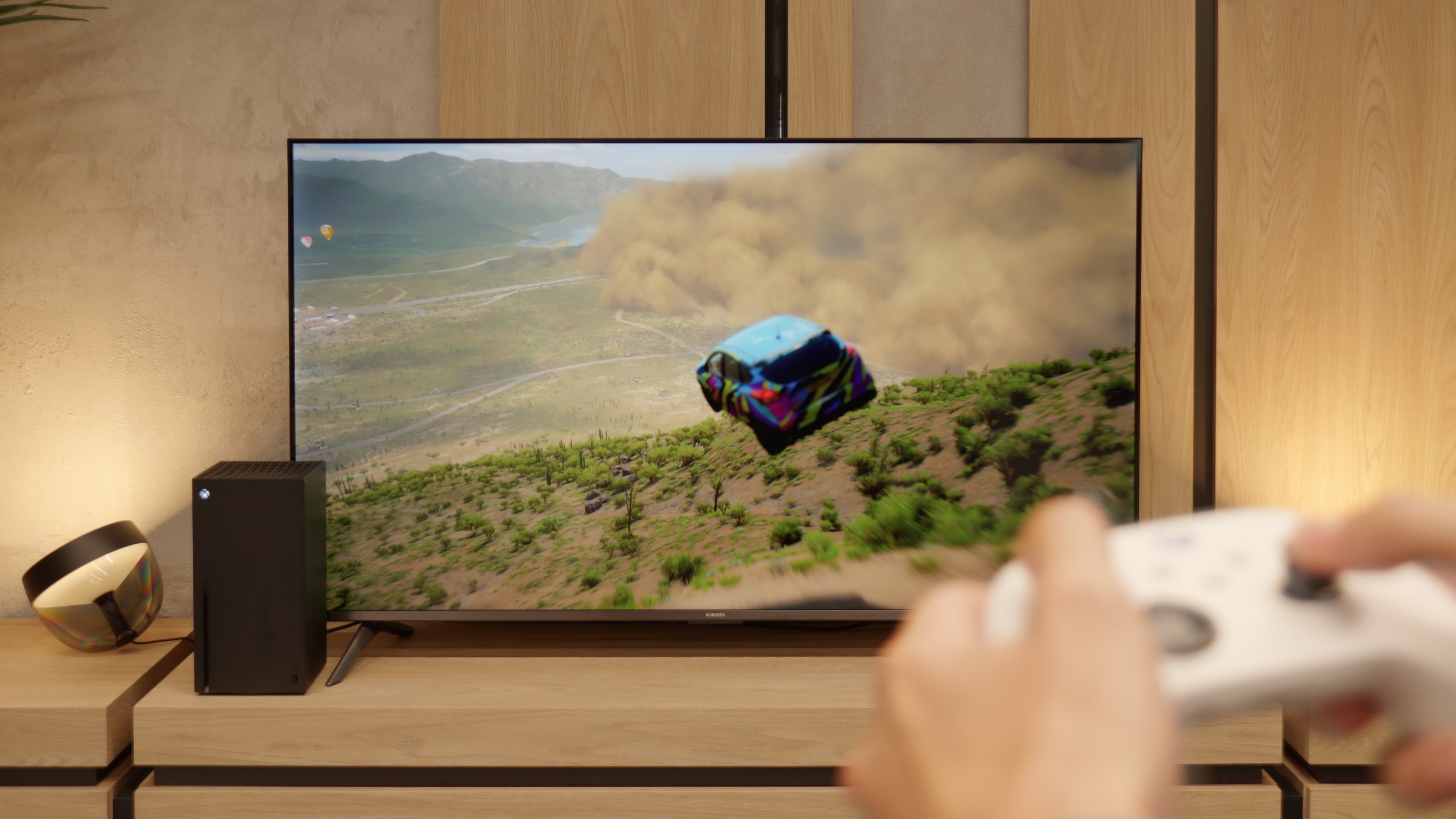
Xiaomi S MiniLED 2025 is a television that has a lot to offer gamers. With two HDMI ports boasting 48 Gbps bandwidth, we can easily connect modern consoles or PCs, utilising their full potential. Additionally, the ALLM feature automatically switches the TV to low latency mode – something we appreciate during fast-paced gaming without annoying lags. No matter what we connect, it runs smoothly, and the TV handles various resolutions exceptionally well. There’s also the GameBar, which may not look as flashy as the "bars" on competing models, but makes up for it in practicality. It’s a straightforward settings panel that allows us to quickly change the most important options or check stats – a perfect solution when time is of the essence.
However, we must admit that navigating the TV itself – or rather, finding gaming features – was quite a challenge for us. We approached the Xiaomi S MiniLED 2025 test several times to locate all the necessary options. The hidden menu allowed us to discover the "GameBoost" feature, which enables switching the TV to 240 Hz mode, activating VRR, and allows for enabling the image in HGIG mode.
In summary, the Xiaomi S MiniLED 2025 is a TV that definitely deserves praise in the gaming equipment category. Its rich set of features – 240 Hz mode, VRR, HGIG, and "GameBoost" – provides an exceptional gaming experience. Unfortunately, the intuitiveness of the menu itself leaves much to be desired and can pose some challenges for the average user.
No indeed – since Xiaomi has added the "Game Boost 120 Hz" feature here, one might expect that they'd follow up with a solid gaming package. Unfortunately, reality quickly dampens that enthusiasm. Aside from this mode (which, it must be said, is a great addition in a budget build), we only have a rather peculiar player panel. It's hard to call it a full-fledged "game bar" – it's more of a simple overlay on the TV's Menu with limited options. And that’s about it. There’s no ALLM, so the TV won’t switch to game mode automatically. There’s no VRR, so you can forget about smooth frame synchronisation. We also won’t find support for Dolby Vision in games or the HGiG format, which are increasingly becoming the standard on consoles. In short: apart from Game Boost 120 Hz, which indeed allows for a more enjoyable experience at 1080p or 1440p, Xiaomi A Pro 2026 offers nothing that particularly appeals to gamers.
Input lag
9.8/10
9.5/10
SDR
HDR
Dolby Vision
Input lag in Xiaomi S MiniLED 2025 is one of its biggest advantages. 8 ms for 120 Hz content and 17 ms for 60 Hz are simply outstanding results that will satisfy even the most demanding gamers. Moreover, the Dolby Vision mode in games deserves praise. Unlike many competing models, Xiaomi maintains a low input lag even in this mode, making it an excellent choice for lovers of high-quality HDR gaming experiences.
Input lag on the Xiaomi A Pro 2026 is quite decent and definitely isn't its weak point. The best results were achieved in 1080p@120 Hz and 1440p@120 Hz modes – there the TV drops below 10 ms, which can easily be called a phenomenal result and sufficient even for more demanding gamers. The situation changes with 60 Hz content – input lag then increases to around 25 ms. These might not be the best figures on the market, but for casual gaming or firing up the console in the evening, they will be fully acceptable. Especially since in most cases, it’s worth activating the 120 Hz mode, which is the most beneficial for gamers.
Compatibility with PC
8.2/10
2/10

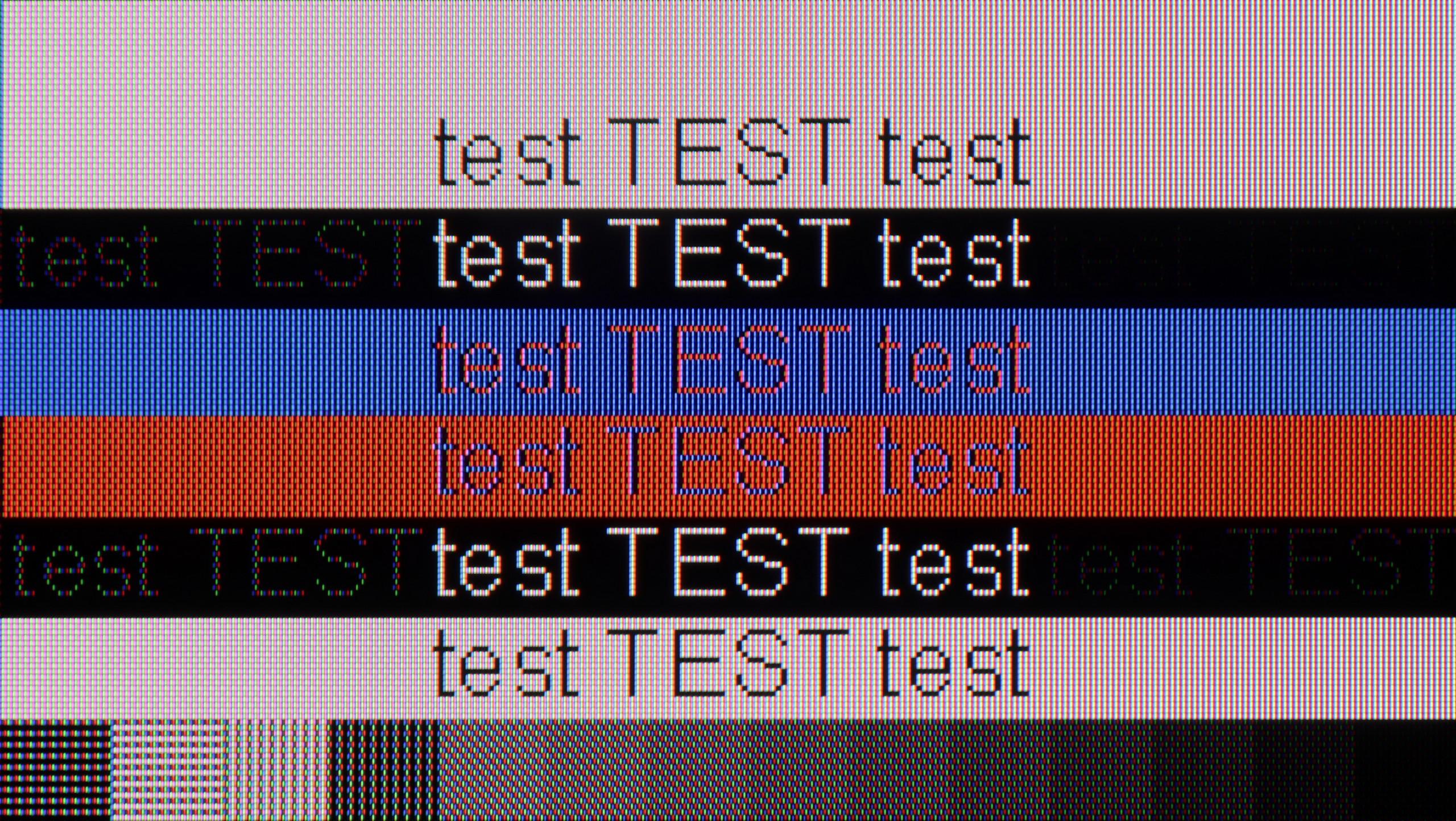
Xiaomi S MiniLED 2025 is a good choice if you need a TV for computer work. The fonts are very clear thanks to 4:4:4 chroma support, making it ideal for office work or browsing documents. It also performs excellently in gaming – high refresh rates, G-SYNC, and low input lag ensure smooth gameplay, which will satisfy most gamers.
Xiaomi A Pro 2026 as a computer monitor? There's no beating around the bush – it’s very poor. While you can still utilise the 120 Hz mode in lower resolutions for gaming, the TV is completely unsuitable for everyday work. It lacks full support for chroma 4:4:4, so fonts appear blurred, and sometimes even rainbow-like. Additionally, there's strong dithering, which makes the image look uneven – some pixels shine brighter while others dimmer, and vertical lines can even break apart. In practice, this means that text (especially coloured and on dark backgrounds) becomes difficult to read. Light text manages to hold up somewhat, but it’s hard to talk about any real comfort. In this category, we give the Xiaomi A Pro 2026 a score of 2/10 (+1 for the additional high refresh rate mode), and there’s really no sense in elaborating on this further.
Viewing angles
3/10
3/10
In terms of viewing angles, Xiaomi S MiniLED 2025 is not impressive. This is a typical problem with VA panels, which struggle without additional coatings to widen viewing angles. The image begins to lose quality when watching the TV from the side – colours fade, and contrast significantly drops. However, the advantage of VA panels is their much better contrast compared to IPS panels, which in turn win when it comes to wider viewing angles. This is a classic compromise where one has to choose between better blacks and a more universal image seen from different spots in the room.
The Xiaomi A Pro 2026 features a VA panel, which immediately suggests that viewing angles are not its strong suit. When looking at the screen from the side, you will quickly notice a loss of quality – colours noticeably fade, and the whole image appears washed out. The drop in brightness may not be as drastic as in some constructions based on similar technology, but that doesn’t change the fact that it’s clearly a weak point of this model. If we plan to use it as a large, cheap screen for the lounge, one must take this limitation into account.
TV efficiency during daytime
7.3/10
4.9/10




Matrix brightness
Average luminance SDR
XIAOMI A PRO 2026: 334 cd/m2
Xiaomi S Mini 2025: 841 cd/m2
Xiaomi S MiniLED 2025 is equipped with a satin finish on the display, which moderately handles glare reduction. On the screen's surface, you can see light reflections, which may be somewhat distracting in bright rooms. However, the key element that saves this television in daytime use is its brightness. With a value of 841 cd/m², the screen performs flawlessly even in very sunlit interiors. This is more than enough to comfortably watch television, movies, or sporting events. Importantly, the television also handles more demanding content, such as winter sports, where the dominant white can pose a significant challenge for other televisions. Here, Xiaomi definitely excels.
The Xiaomi A Pro 2026 performs quite well during the day. The display has a satin finish that helps reduce reflections, so colours don’t lose their vibrancy, even when the room is bright. Just bear in mind that it’s not an extremely bright screen – the average brightness is around 350 nits. In an ordinary, moderately sunny living room, it’s sufficient, but if you have large windows that let in a lot of sunlight, it might simply be tough without blinds or curtains.
Details about the matrix
Subpixel Structure:

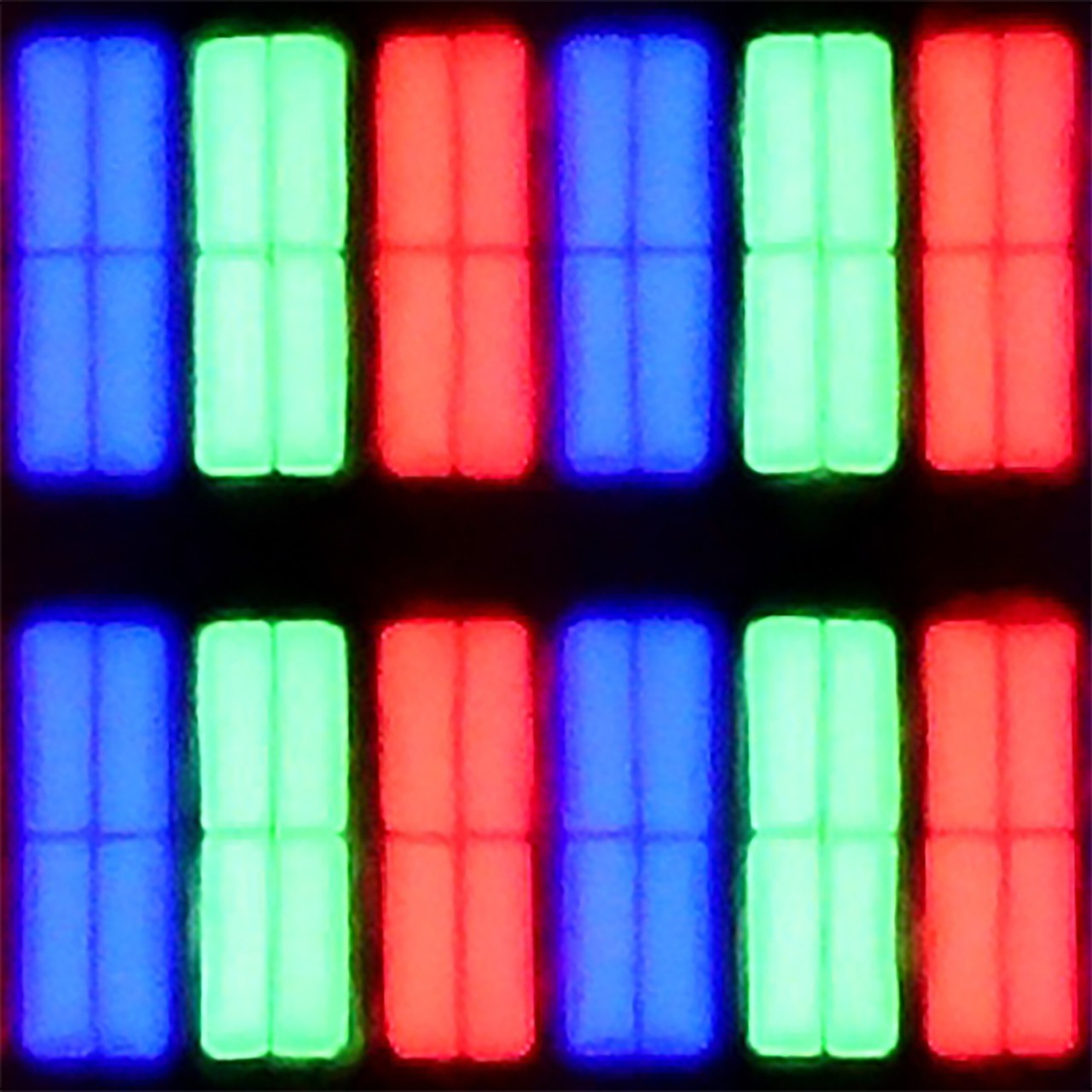
Panel uniformity and thermal imaging:


TV features
4.7/10
6.1/10
- HDMI inputs1 x HDMI 2.0, 2 x HDMI 2.1 48Gbps3 x HDMI 2.0, 0 x HDMI 2.1
- Other inputsRCA (Chinch)
- OutputsToslink (Optical audio), eARC (HDMI), ARC (HDMI), Mini-Jack (Headphones)Toslink (Optical audio), eARC (HDMI), ARC (HDMI), Mini-Jack (Headphones)
- Network InterfacesWi-Fi 2.4GHz, Wi-Fi 5GHz, Ethernet (LAN) 100MbpsWi-Fi 2.4GHz, Wi-Fi 5GHz, Ethernet (LAN) 100Mbps
- TV receptionDVB-T, DVB-T2, DVB-S, DVB-S2, DVB-CDVB-T, DVB-T2, DVB-S, DVB-S2, DVB-C
Classic features:
- Recording to USB (terrestrial TV)
- Recording programming
- Picture in Picture (PiP)
- RF remote control (no need to aim at the screen)
- Backlit remote control
- Teletext
- Audio only mode
- Bluetooth headphones support
- Simultaneous Bluetooth headphones & TV audio
Smart features:
- AirPlay
- Screen mirroring (Windows Miracast)
- Voice search
- Voice search in native language
- Ability to connect a keyboard and mouse


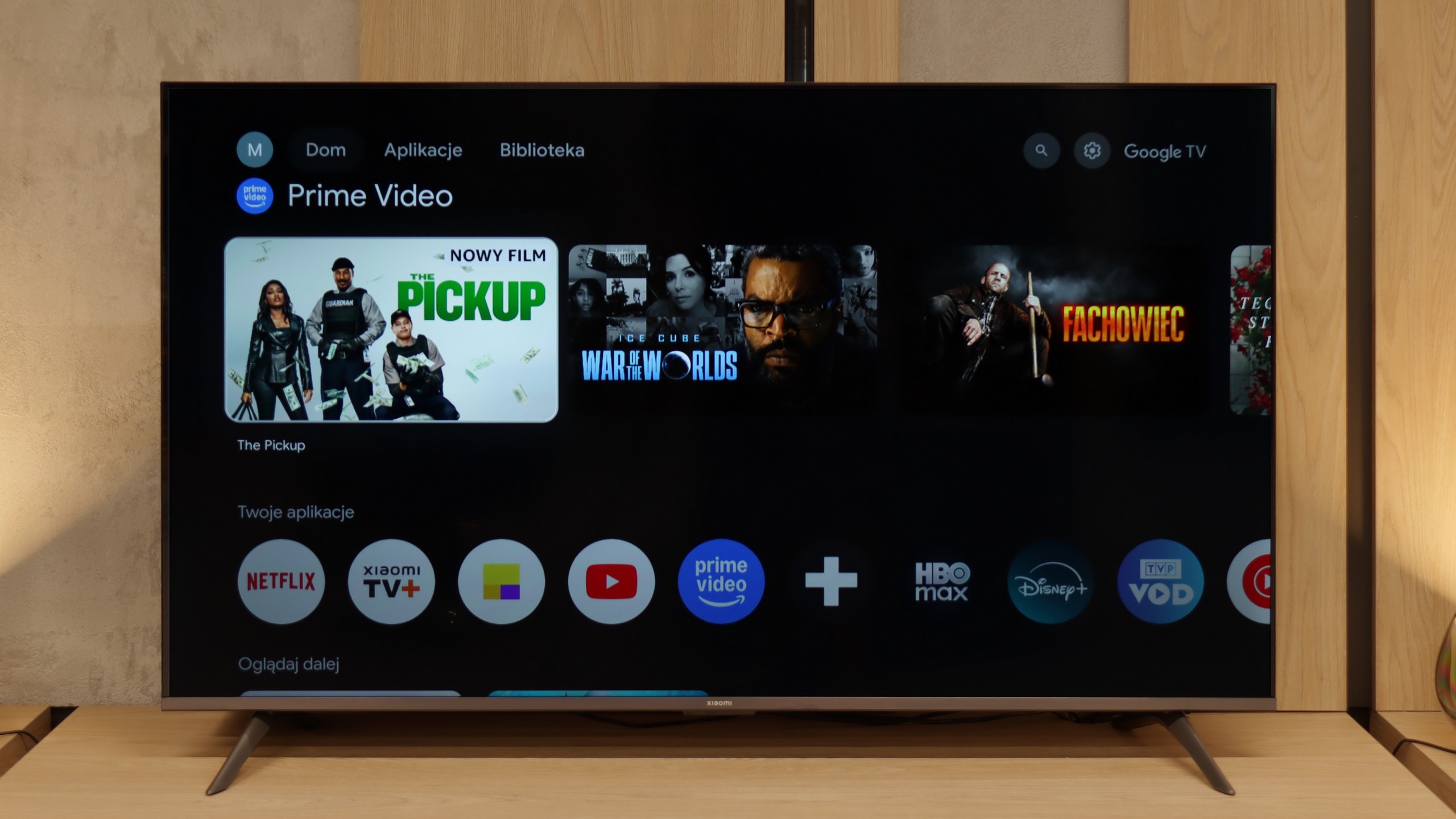
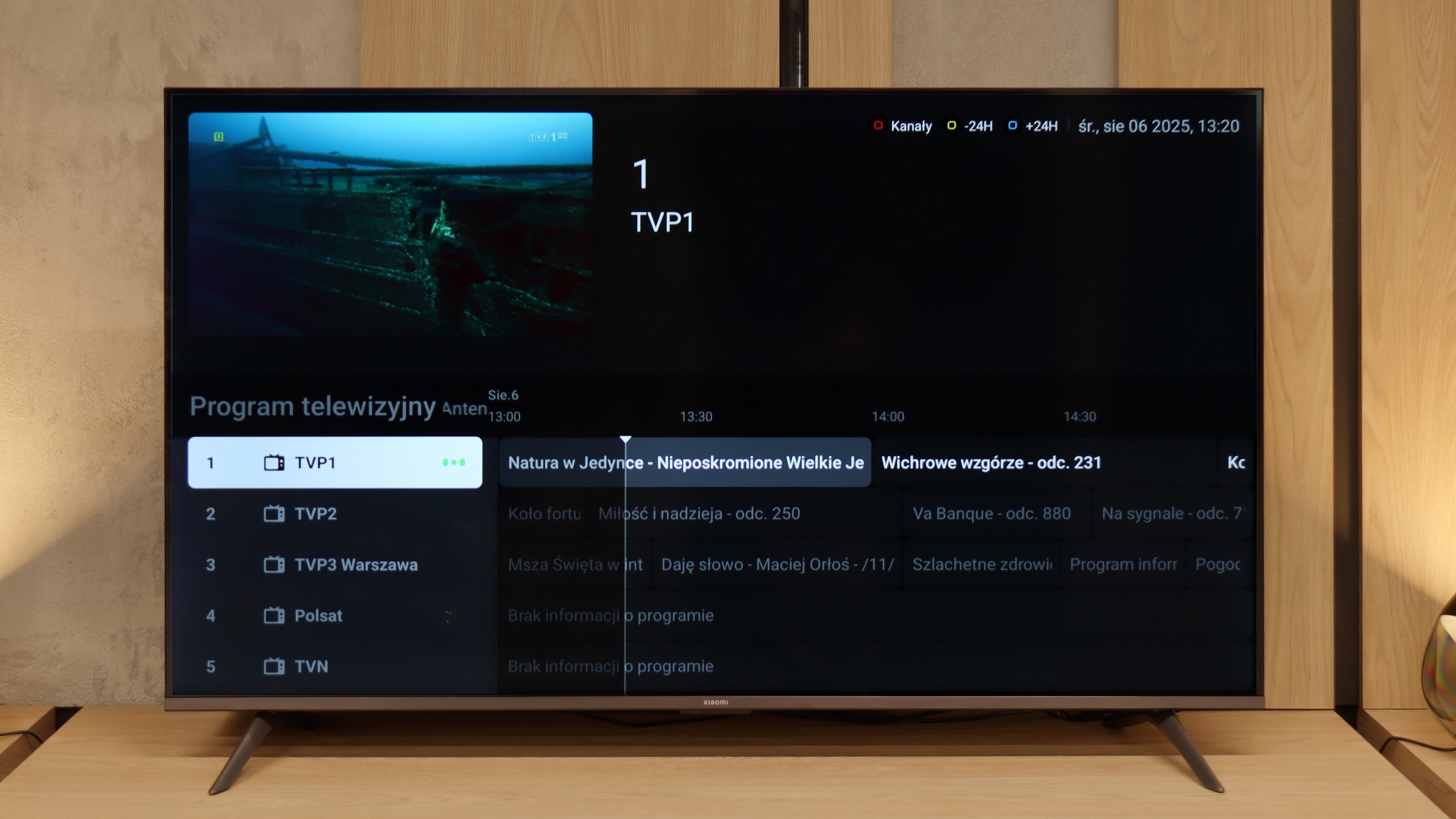
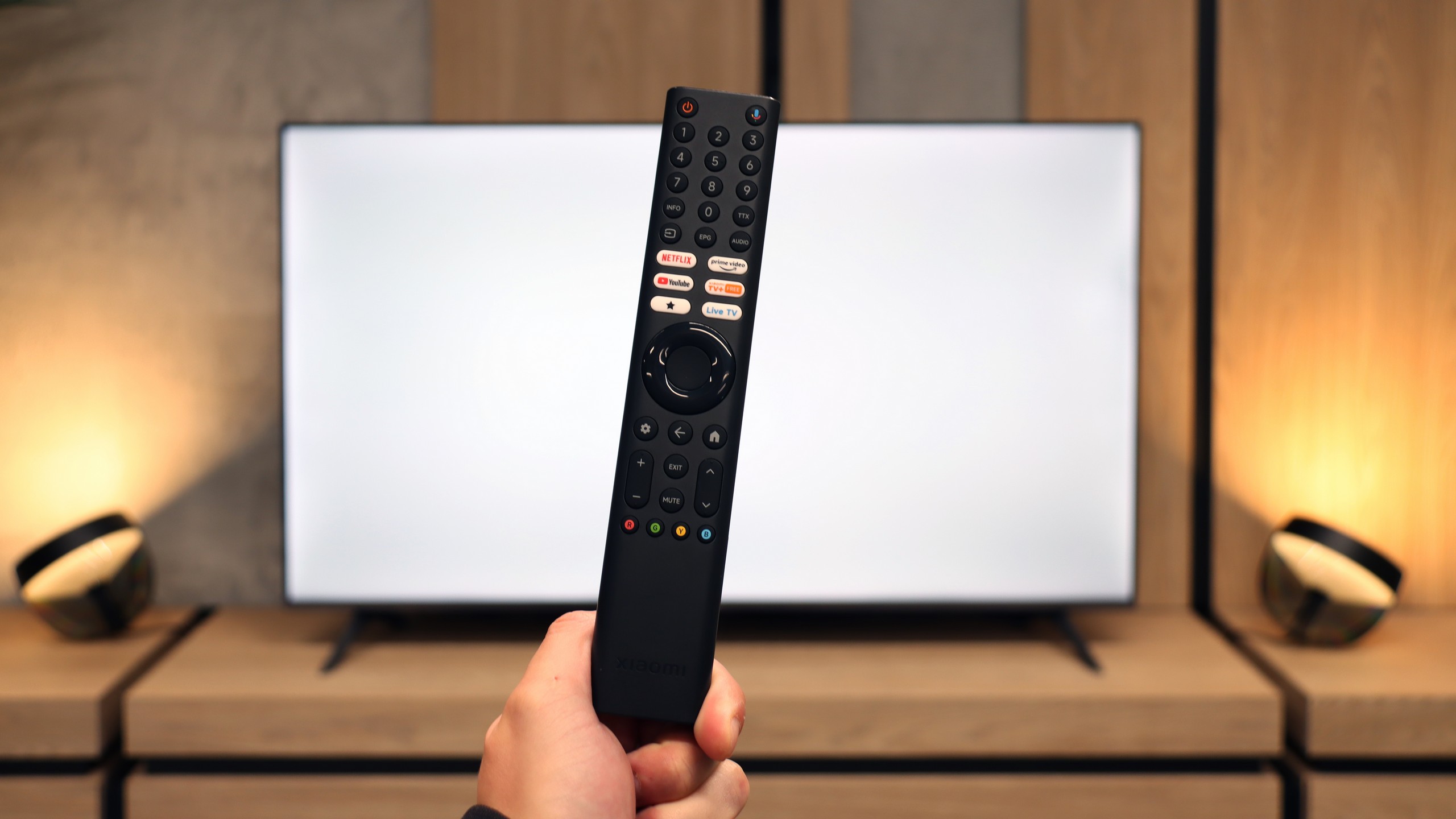
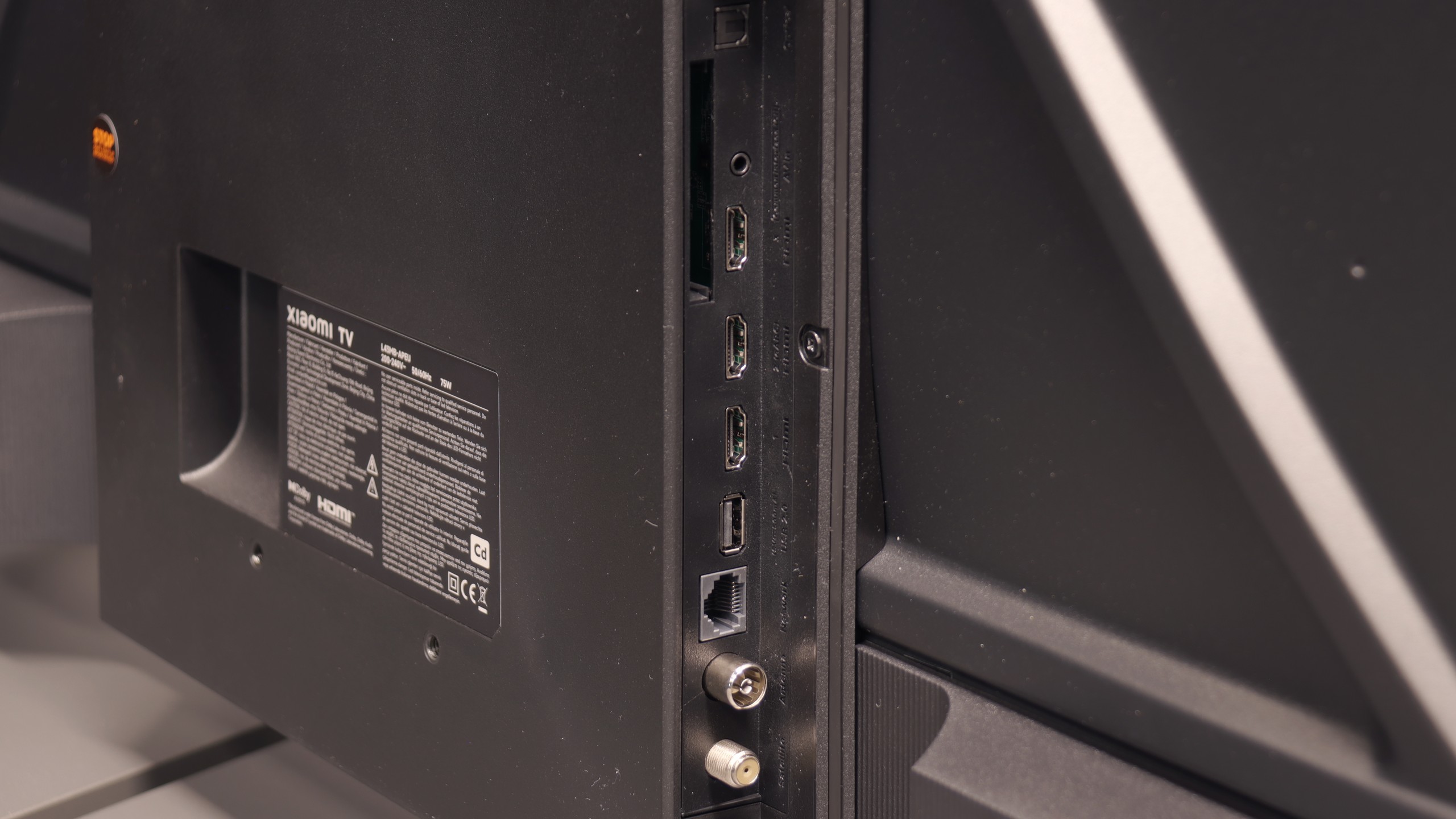
Xiaomi S MiniLED 2025 is a television that stands out thanks to the Google TV system. It offers access to the most popular streaming services, music apps, and various useful features that significantly enhance everyday use of the TV. For those who enjoy personalisation, the system also provides plenty of configuration options.
The built-in voice assistant operates smoothly – we can not only control the TV but also ask for the weather forecast or set a reminder for the next day. Unfortunately, we noticed during testing that some functions have trouble translating into Polish, which can be annoying, especially for those less proficient in navigating the settings. Despite this, the overall impression is very good, and minor shortcomings can be improved in updates.
The device handles connectivity well. Wireless connections with Windows computers or Apple devices run smoothly, and thanks to Bluetooth, we can easily connect headphones, keyboards, or other accessories. The remote is simple and convenient – it works from any position, so aiming at the screen is not necessary. However, there are some shortcomings. If someone frequently uses traditional television, they might miss the recording functions from tuners or the PiP (picture in picture) option. This somewhat limits the possibilities, but for those focusing on streaming and modern features, it won’t be a major issue.
Xiaomi compensates for these shortcomings with an excellent operating system. Google TV is one of the most advanced and intuitive systems available on the market, which makes the television perform really well in daily use.
SmartTV- Google TV
The biggest plus of the Xiaomi A Pro 2026 is the Google TV system. It gives the television a second life – you can run almost any app on it, from Netflix and YouTube to music services and even lesser-known programs from the Google Play store. We are not limited to what the manufacturer has pre-installed, as is often the case with other budget televisions. On top of that, we have AirPlay, voice search via Google Assistant, and even integration with Gemini. We did experience some small hiccups – for instance, screen mirroring from a laptop didn’t always work – but despite these shortcomings, Google TV is a huge advantage of this model.
Classic TV functions
The Xiaomi A Pro 2026 can be described as a "senior-friendly" television. The large remote with a numeric keypad and a considerable number of physical buttons makes it intuitive to operate. Support for teletext and a clear EPG interface make it easy to use classic television functions. We won’t find many advanced features like USB recording or PiP functionality, but the presence of an analogue headphone jack output can be surprisingly practical for some users. It gives the impression that this is a set of features tailored to the needs of the most traditional viewers.
System stability
However, not everything works as it should. During testing, we encountered annoying system lags, issues with Miracast, and problems when switching audio sources. There were times when a reset of the television was necessary by unplugging it from the power. This only shows that while Google TV offers enormous possibilities, the stability can still be very problematic in such a budget-friendly model.
Playing files from USB
7.3/10
6.8/10
Supported photo formats:
Maximum photo resolution:

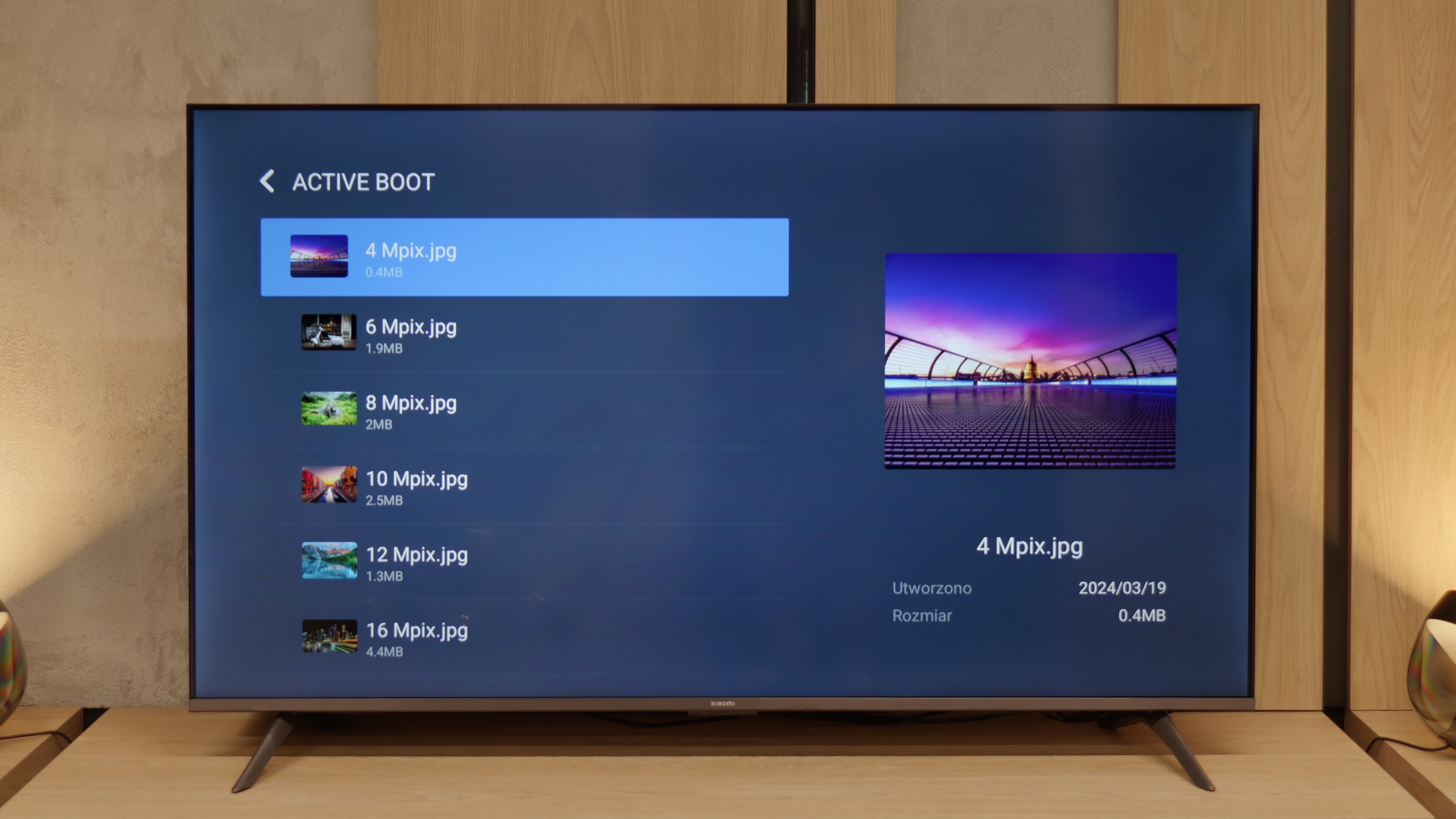
The basic file player in Xiaomi S MiniLED 2025 performs its task for simple video materials. However, a noticeable drawback is the lack of support for Polish characters, which can be problematic for individuals using subtitles.
Fortunately, the presence of the Google TV system provides a way to easily work around this limitation. It allows for the installation of alternative file playback applications that handle Polish characters and offer significantly more advanced options. As a result, the limitations of the built-in player are not as burdensome as they may seem.
The built-in media player in the Xiaomi A Pro 2026 is quite a conundrum. On one hand, it plays most popular audio and video formats without major issues. On the other hand, it can struggle with basic things like Polish characters. Files with letters such as ą, ł, ć, or ś in the name often refuse to open or display incorrectly. It looks strange, because we supposedly have codec support, yet the TV simply gets lost on straightforward matters related to the alphabet. Fortunately, this isn’t a huge problem, as thanks to Google TV we can simply install another player, like VLC. At that point, the issue with Polish characters totally disappears and media usage becomes seamless.
Apps
9.6/10
9.6/10














































Sound
6.8/10
5/10
- Maximum volume-81dB
- Dolby Digital Plus 7.1
- Dolby True HD 7.1
- Dolby Atmos in Dolby Digital Plus (JOC)
- Dolby Atmos in Dolby True HD
- DTS:X in DTS-HD MA
- DTS-HD Master Audio
Xiaomi S MiniLED 2025 sounds really pleasant, and even offers a light bass, reminiscent of the sound known from the lower model, the A Pro 2025. The sound is well balanced, making watching movies or listening to music comfortable, even without additional audio equipment. Interestingly, the television seamlessly supports audio formats like Dolby Atmos and the less common DTS:X. This allows you to connect a home theatre system or soundbar and enjoy spatial sound without any difficulties. A nice addition is also the presence of a standard speaker jack connection.
Last year, the Xiaomi A Pro 2025 surprised us with its pretty decent sound for a super budget segment television. Unfortunately, this year's edition – the A Pro 2026, has completely let us down. The sound feels like it's coming from underwater: flat, lacking any bass or depth. The only positive is the wide support for audio formats like Dolby Atmos and DTS:X, but in practice, it doesn't really change much. If you're considering this television, you'll need to factor in a soundbar straight away, as the audio experience without it will be quite disappointing.
Acoustic Measurements
No acoustic data
81dBC (Max)
75dBC


